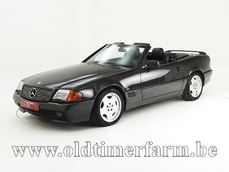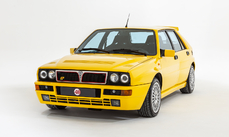Mercedes-Benz 500SL r129 500SL 1990
General description :
Equipment
Two-tone Astral Silver metallic paintwork (735), Grey leather upholstery (278A), 15-inch 15-hole alloy wheels, Electric folding soft-top in black (740), Removable hardtop in Astral Silver metallic, 5-litre V8 engine, 4-speed automatic transmission, Electrically-adjustable front seats with memory (241/242), Air conditioning (580), Cruise control (440), Blaupunkt Verona cassette radio, Electric steering column, Rear view mirror with memory (246), Rear seats (565), Wind deflector (283), Heat-insulating glass all-around with heated rear window (593), Headlight wash/wipe (600), Model designation delete (260), Infrared remote central locking (880), Anti-theft warning system (551), Self-leveling suspension all-around with adaptive damping system (ADS) (216), Acceleration Slip Regulation (ASR) (471), Non-catalyst (828), Cassette storage, Warning triangle, Alloy spare wheel, Spare remote key, Mercedes-Benz overmats in grey, Factory data card, Hardtop stand.
Exterior
Finished in classic two-tone Astral Silver this lovely V8 SL looks fantastic beneath our studio lights. We love the angular pre-facelift design of the early R129s, with original features such as the large amber indicators and satin lower body elements really adding to the sense of occasion. The car is very well presented with clear and unmarked headlights, arrow-straight flanks, and uniform panel gaps. The original 15-hole wheels are also pristine with matching Michelin rubber at each corner. The removable hardtop is just as clean as the rest of the car and the electric soft-top is excellent with no damage to the fabric or rear windows.
VIEWINGS WELCOME BY APPOINTMENT ONLY /// ADDITIONAL PHOTOS AND VIDEOS AVAILABLE UPON REQUEST
Interior
Trimmed in complementing light grey the SL’s interior feels light and airy even with the hood up. The seats are well preserved with only the lightest of wear to the bolsters, the leather is still notable soft, and the electric adjustments all work correctly. Glancing across the dash everything looks nice and crisp; the glossy walnut trim has a deep shine and the spectacle glovebox opens without fuss. The switchgear is also reassuringly solid to operate and everything works as it should including the air conditioning, folding roof, and roll over bar. A period-correct Blaupunkt Verona tape deck is fitted, and in the centre console there’s plenty of storage for all your favorite cassettes.
ENGINE & TRANSMISSION
This SL is equipped with the desirable Mercedes-Benz 5-litre V8 producing an impressive 322hp. Lifting the bonnet the engine bay is particularly clean and tidy with no signs of any damage or previous poor repair. Unsurprisingly the car performs really well on test; the engine feels strong and the gearbox is very smooth indeed. For the new keeper’s peace of mind, a full mechanical inspection has just been completed by our trusted local workshop who also carried out 4-wheel alignment and an MOT test.
History File
This lovely 500SL was originally supplied by Caffyns Mercedes-Benz in September 1990. Now 34 years old the car has driven only 56k miles in the hands of 6 owners. The original Mercedes document wallet and handbooks are all present in the History File along with the service book and accompanying invoices, MOT certificates, a spare remote key, and the current V5 registration document showing only 5 former keepers. A breakdown of the car’s service history is below.
12/09/1990 – PDI – Caffyns Mercedes-Benz07/01/1991 at 859 miles – Clover Leaf Cars Mercedes-Benz01/07/1991 at 6,637 miles – Caffyns Mercedes-Benz21/11/1991 at 11,544 miles – Bradshaw Webb Mercedes-Benz13/10/1992 at 22,311 miles – Caffyns Mercedes-Benz19/05/1993 at 28,470 miles – Bradshaw Webb Mercedes-Benz15/09/1993 at 31,249 miles – Bradshaw Webb Mercedes-Benz10/01/1994 at 35,269 miles – Bradshaw Webb Mercedes-Benz11/08/1995 at 41,150 miles – Drayton of Stoke Mercedes-Benz11/09/1997 at 47,540 miles – Drayton of Stoke Mercedes-Benz16/08/1999 at 49,103 miles – Hills of Shrewsbury Mercedes-Benz17/04/2008 at 53,473 miles – Drayton of Stafford Mercedes-Benz11/04/2019 at 54,604 miles – Mercedes-Benz of Stafford01/12/2021 at 54,660 miles – SS Motors Mercedes-Benz specialist10/05/2023 at 56,467 miles – SL Shop Mercedes-Benz specialist17/07/2023 at 56,470 miles – MB Automotive Mercedes-Benz specialist (transmission service + brake fluid change)
1990 Mercedes-Benz 500SL r129 500SL is listed for sale on ClassicDigest in Hampshire by 4Star Classics for £19995.
Car Facts
Car type : Car Make : Mercedes-Benz Model : 500SL r129 Model Version : 500SL Engine size : 5.0 Model Year : 1990 Sub type : Station wagon Location : Hampshire Vehicle Registration : Undefined
19995 £
People who viewed this Mercedes-Benz 500SL r129 also viewed similar Mercedes-Benz listed at ClassicDigest
Other cars listed for sale by this dealer
About Mercedes-Benz
In the annals of automotive history, the journey of Mercedes-Benz is a tale that unfolds with the ingenuity of its founding pioneers. In the year 1886, Karl Benz crafted the Benz Patent Motorwagen, a creation that would go down in history as the world's inaugural automobile. Unbeknownst to him, this moment marked the genesis of what would evolve into the most illustrious premium car manufacturer globally. The financial underpinning of this pioneering venture, interestingly, was provided by Karl Benz's wife, Bertha Benz, demonstrating a remarkable partnership that would set the tone for Mercedes-Benz's legacy.A parallel narrative emerged not far away, as Daimler-Motoren-Gesellschaft, founded by Gottlieb Daimler and Wilhelm Maybach, entered the scene. In 1901, they unveiled their automobile under the now-famous moniker "Mercedes," meaning "godsend" in Spanish. This name was bestowed upon the car at the behest of Emil Jellinek's daughter, the distributor for Daimler-Motoren-Gesellschaft. The wheels of innovation were set in motion.
Fast forward to 1926, a pivotal year that witnessed the merger of Daimler with Benz & Cie., culminating in the birth of Daimler-Benz. The amalgamation saw the adoption of "Mercedes-Benz" as the distinguished trademark for their automobiles, fusing the legacies of two visionary entities into one.
Contrary to perceptions of conservatism, the trajectory of Daimler-Benz unfolds as a chronicle of industry firsts. From the introduction of the honeycomb radiator to the float carburetor, and the pioneering implementation of four-wheel brakes in 1924, Daimler-Benz consistently pushed the boundaries of automotive innovation. The diesel-powered Mercedes-Benz 260 D in 1936 marked the inception of diesel engines in passenger cars. The iconic Mercedes-Benz 300SL Gullwing made history as the first car with direct fuel injection, albeit the Gutbrod's tiny 2-stroke engine can claim precedence.
Safety innovations became a hallmark, with Béla Barényi's patented safety cell design in the "Ponton"-models in 1951, featuring front and rear crumple zones. The W116 450SEL 6.9 saw the introduction of the Anti-Lock Brake system (ABS), another pioneering safety feature. From the first production airbags and beyond, the legacy of "firsts" continued to be etched into the fabric of Daimler-Benz.
Over its centennial journey, Mercedes-Benz has not merely produced cars but has sculpted automotive icons. The SSKL, 710 SSK Trossi Roadster, 770K Grosser, 540K Spezial Roadster, 300SL Gullwing, w100 600 Pullman, w111 280SE 3.5 Flachkühler, w113 230SL Pagoda, w109 300 SEL 6.3, and w201 2.3-16 Cosworth stand testament to the brand's commitment to engineering excellence.
The roaring Silver Arrows, or "Silberpfeile," including the W 25, W 125, W154, W165, and W196, created a legacy of dominance on the racetrack. These machines were not merely cars; they were expressions of precision, speed, and an indomitable spirit that left their competitors in the dust.
As Mercedes-Benz marches into the future, it does so not just as an automaker but as a custodian of a legacy, a torchbearer of innovation, and a beacon of automotive excellence. The road ahead is sure to witness the continued fusion of cutting-edge technology, timeless design, and an unwavering commitment to setting new standards in the world of automobiles.
One luminary figure who left an indelible mark was Béla Barényi, often heralded as the "father of passive safety" for his pioneering work in safety engineering. His patented safety cell design, featuring front and rear crumple zones, became a hallmark of Mercedes-Benz's commitment to occupant safety, setting new standards that reverberated throughout the automotive world.
Moving through the chronicles, the collaborative genius of Wilhelm Maybach, alongside Gottlieb Daimler, laid the foundation for Daimler-Motoren-Gesellschaft. Their innovations not only birthed the first Mercedes but established a culture of relentless pursuit of technological excellence that remains integral to Mercedes-Benz's DNA.
In the post-merger era of 1926, Ferdinand Porsche emerged as a prominent figure within Mercedes-Benz. His work on the Mercedes-Benz S-Type, a supercharged race car, garnered acclaim and set the stage for a legacy that extended far beyond the marque. Porsche's impact would later extend to his eponymous company, but his influence at Mercedes-Benz during those formative years was pivotal.
As the 20th century progressed, the legendary Rudolf Uhlenhaut emerged as a key figure. Uhlenhaut, an accomplished engineer and the driving force behind the iconic Silver Arrows, played a crucial role in Mercedes-Benz's dominance in motorsports. His engineering prowess and attention to detail were instrumental in creating some of the most formidable racing cars of the era.
In the latter half of the century, figures like Bruno Sacco, the head of design at Mercedes-Benz from 1975 to 1999, left an indelible imprint on the brand's aesthetic identity. Sacco's design philosophy, characterized by clean lines and timeless elegance, shaped iconic models like the W126 S-Class and the W201 190E, solidifying Mercedes-Benz's reputation for luxury and sophistication.
The narrative would be incomplete without acknowledging the contributions of engineers like Hans Scherenberg, whose leadership in the 1970s ushered in a new era of technological innovation at Mercedes-Benz. Scherenberg's tenure saw the development of groundbreaking technologies, including the Anti-Lock Brake system (ABS) and the introduction of airbags in production cars.





































